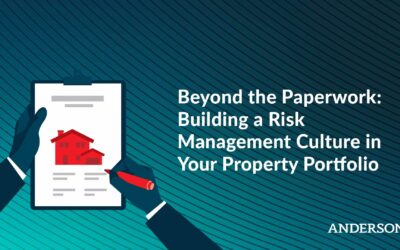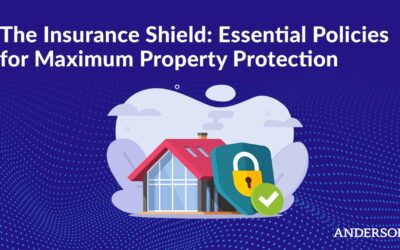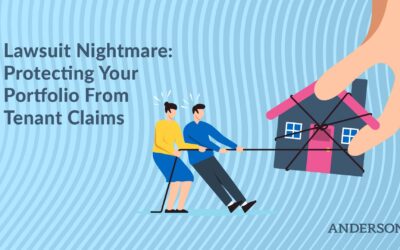Societal issues surrounding autism not only create challenges for children, but their entire family. Parents of children with autism experience anxiety and uncertainty, especially as their children grow up to become adults with autism. Chances are, they will survive their parents. Then, what will happen? Where and how will they live as adults with autism?
In this episode, Toby Mathis of Anderson Advisors talks to Jim Richardson from Neuro Diverse Living. Jim has more than 35 years of consulting services experience and has been investing in real estate for 40+ years. As a principal in a commercial real estate capital consulting firm, Jim raises and manages discretionary investment capital. As a parent of a grown son with autism, Jim’s business vision and personal mission is to connect in a meaningful way.
Highlights/Topics:
- What will happen to Jim’s son, Michael? Every parent raising an autistic child has or will consider available options to plan for future living accommodations.
- What are options most parents consider? Many families make plans with a sibling, such as a brother, sister, aunt, uncle, or other family member, which may only be temporary.
- What about a permanent move? Jim wanted to find a place where Michael could move to and theoretically live for the rest of his life.
- Why? Change for an autistic adult can turn their world upside down. Once might be fine, but not multiple moves.
- What about group homes? These temporary properties tend to be for people with severe disabilities. Unless Michael gets to the point where he needs that next level of care, a group home can’t accommodate him.
- What’s a parent to do? Create their own long-term housing solution to meet Michael’s needs as an adult with autism. Jim and his wife, Nancy, started Neuro Diverse Living.
- Does Michael live with Jim and Nancy? Yes, because they are setting up their first personal care home, also known as residential assisted living (RAL).
- Will the personal care home only be for adults with autism? Neuro Diverse Living is a 501(c)(3) charity with a blended residence of autistic adults and neurodiverse people.
- Will Neuro Diverse Living offer 24/7 care? To be a legitimate business, Jim needs to follow local, state, and federal regulations. Jim’s business will provide housing based on the level of daily living that each individual needs.
- How many people have autism? Nationally, on average, 1 out of 49 people are on the autistic spectrum. In the next 10 years, 1 out of every 4 or 5 adults could have autism.
- Why create an intentional design for Neuro Diverse Living? Jim intends to make the design model available to other families that want to do something similar.
- Is it difficult for autistic adults to get a job? For every 10 jobs available, about two could go to an autistic individual.
- Why does Jim have a separate group that buys properties for him? There’s a tremendous need/opportunity for long-term leases for autistic and neurodiverse homes.
- Did autism used to be confused with schizophrenia? Yes, years ago. People thought it was some sort of major mental defect. They didn’t know what it was or how to treat it.
Resources:
Drexel University’s Autism Research Foundation
Madison House Autism Foundation
Anderson Advisors Tax and Asset Protection Event
Full Episode Transcript:
Toby: Guys, you’re listening to the Anderson Advisors Podcast. This is Toby Mathis and with me today is Jim Richardson. Hey, Jim.
... Read Full TranscriptJim: Hey, Toby.
Toby: Jim’s got a really interesting story. I won’t get into all of it but what we’re going to be talking about today is certain issues that we have in society and a way to solve them, specifically with autism. More specifically yet are adults with autism, living accommodations, and dealing with a lot of the pain that a lot of the parents are finding. We know that the chances are the children will outlive the parents. In these circumstances, that could be a source of anxiety for the parents.
I want to hand it off to Jim just to give a thumbnail sketch of what his experience in this arena is and what he’s done to address some of those pain points that he, unfortunately, has had to experience—that a lot of you guys are also experiencing. Welcome, Jim.
Jim: Thanks very much for taking the time. I appreciate it. The thumbnail intro, Toby, our experiences as a parent of a 26-year-old son with autism. We’ve always known that this day would come where we have to figure out what’s going to happen to Michael, our son, when we’re no longer here. It is the same question I am sure every parent raising an autistic child has or will think about at some point throughout their life. We’ve thought about it for a long time. Maybe a few years ago we started looking into options that were available here for us.
Clearly, an option many families have taken is that they make plans with one of their siblings. Whether it’s a brother, sister, aunt, uncle, or a family member that may take care of Timmy or Sally when mom and dad are no longer around. We certainly had those same thoughts ourselves, but we realized that no matter what we did, it was probably a temporary fix. Because if we were, for example, have our son Michael go live with one of his aunts or uncles, what’s going to happen to him when they’re not able to take care of him?
For us, Toby, it was a very personal thing. I’m sure it is for every parent, but it became a matter of we didn’t want Michael to have to move every 5-6 years. Change is hard for everybody. Change for an autistic adult can be rattling. It can turn their world upside down. Doing it once might be okay, but then doing it one home for five years, another location for five years. It just wasn’t what we wanted to do.
We wanted to find a place where Michael could move to—at some point—and theoretically live for the rest of his life. That was a big challenge because they really don’t exist today. In my opinion and the research I’ve done as a father, as a parent, there are homes. We live in Pennsylvania, and there really isn’t the type of home that we wanted for Michael. There are group homes, but they tend to be (in Eastern Pennsylvania) for folks that have a severe disability. There are three, maybe a maximum of four individuals living in a group home.
But Michael didn’t need that, and even there, it was only for a period of time. When Michael gets to the point where he needs that next level of care, a group home today in our area wouldn’t be able to accommodate him. So there yet is another planned or an unplanned move. We don’t know if it’s 5 years, in the future 10, or whatever.
We’ve thought long and hard and we felt like it was something we could take care of for Michael. We could solve Michael’s long-term housing needs. […] If we could solve it for Michael we could solve it for two more families, for four more, for five more, or for ten more.
That’s where the whole idea came from. It came out of a need for my wife Nancy and I to find a long-term solution for Michael, and that’s where Neuro Diverse Living really came from.
Toby: Does Michael still live with you now?
Jim: He does. He lives with us because we are in the process of setting up our first personal care home. That’s a distinction. We’ll probably use that term a little bit here during this call. In Pennsylvania, the type of residence that we’re looking to establish is a personal care home. In some states, they’re called assisted residential living or residential assisted living. Here in Pennsylvania were personal care homes.
Toby: The personal care home would be for adults with autism? Would all of the occupants, the residents be autistic adults?
Jim: That’s a great question because the reason we settled on Neuro Diverse Living as the name for our 501(c)(3), our charity is because we think that there’s an opportunity to have a blended residence where there would be a number of adults with autism. There might be a few residents that are neurotypical that might want to live in a community environment specifically like caregivers.
Caregivers we think may want to live in and they’re not going to be autistic. We’re not just limiting it to autistic adults—although we can. We’re looking at other neurodiverse individuals. Maybe somebody with down syndrome or another intellectual developmental disability. That broad spectrum of neurodiverse is really where we’re focused, but it’s aimed at the autistic adult population.
Toby: What types of things? You and I have talked about this before, but most people haven’t dealt with this. Is this something where there’s 24/7 care? Is this something where it’s just house mom that takes care of the home? What is the scenario for Neuro Diverse Living?
Jim: With no disrespect to anyone who’s going down this path, but to be a legitimate business where folks can come—and if they want to redirect some of their waiver funding or they want to direct some of their personal funds for this—there are regulations that we need to line up against from the state of Pennsylvania. Actually, there are two sets of regulations.
One is for a personal care home and that can be for seniors as well. There are personal care homes in the state for seniors that don’t have neurodiversity, but when we’re looking at folks that have autism, we’ve got the personal care home regulations and then we’ve got a separate set of regulations that apply for those with an ADD or autism.
We believe that it’s not a stay-at-home mom, although, we could. We live in a home where we have four bedrooms. My wife and I occupy one, Michael’s got a second, and we have two open bedrooms. We could open up our home, but then that would require—if they needed 24-hour care, which Michael doesn’t. And that’s the thing, Toby, that also is going to make us different. We’re going to provide the type of housing with the level of daily living that each individual needs.
Probably the first time we open up within the next six months. We’re getting real close. We’re probably not going to open it up for folks that need 24/7 care because Michael doesn’t. We believe from all the folks we’ve talked to at Drexel University, their autism research foundation. We’ve talked to folks at Madison House. It tends to be better for individuals when they’re with other folks.
Michael would probably do very well with folks that are like him. He’s very independent, but he’ll never be able to drive. He’ll never really be able to hold down a full-time job only because we struggle to find suitable work. But we think that in a small home—and what we’re looking at are homes that have five or six bedrooms. Each has their own private bath, which is important. And we’re going to give a parent the opportunity to say I’d like my son or daughter to have their own bedroom, or I don’t mind them sharing a bedroom with one other person, which will cut the cost literally in half.
We’re looking to establish homes that some may have 24/7 care. But for the most part—even for those like Michael—we will need to have someone there 24 hours a day, 7 days a week just to provide that care should they need it. Michael doesn’t need help feeding himself, doing his laundry, or bathing. Very self-sufficient. But the rules and the laws in Pennsylvania require at least one caregiver for that type of property.
Toby: Yeah. It makes sense. Let’s step back for a second because a lot of people are like whoa, how many autistic folks are really out there? The diagnosis now, if I’m not mistaken, is 1 out of 60 or less. There’s a lot of folks that are now on the autistic spectrum and there’s a big range.
Jim: There is a huge range, Toby. It is a spectrum disorder. You’re either severely autistic or you’re mildly autistic, but everyone’s different. In terms of the numbers, the rate now is around 1 in 49 nationally on average.
Toby: It’s high. People are saying, in the next 10 years, 1 out of every 4 or 5 adults in the US could have some form of autism spectrum disorder. That’s pretty pervasive. The numbers are around 50,000 children age out of the school system every year. Over 10 years, that’s another half million. What’s sad is that even government funding goes to a point where they follow kids through school and then they fall off that proverbial autism cliff.
Toby: And they rely on the parents to pretty much take care of these kids.
Jim: Absolutely. Even where we live, we moved to this school district 22 years ago because it was the third-best school district in the state of Pennsylvania. Michael went until he was 21, but then it was all on us. Everything became on us. Whatever services we were able to get from the state, the rest we had to supplement ourselves.
In Pennsylvania—and this was from the last census that was done—by 2025 (so in the next 5 years), there’s going to be over 40,000 adults who are going to be requiring some sort of assistance with their living. If you just think about that number—
Toby: Just from autism, right?
Jim: Just from autism. You think about the need in Pennsylvania alone. One of the other things that we’ve done as an intentional design for Neuro Diverse Living is we intend to make our model available to other families who want to do something similar. I don’t think we will ever be able to provide enough housing for everyone that needs it. The long-term plan—over the next 10 years—is to stand up these single-family homes, small apartments, but to keep it manageable.
If we can do 1 in the next 6 months, then 2 in the next 12 months, and maybe 4 in the next 2 years. If you think of having 6-8 residents in each 1 of these homes, the math just doesn’t satisfy the demand that’s out there. We’re going to be very open and transparent about how we’re doing it, how we made that journey, that transition. And if a family wants to attack this one on their own, that’s great.
Toby: Just because there’s such a diversity—let’s go over some of the stats that are going to probably freak some people out. First off, if you have 100 adults that are on the autistic spectrum, what percentage of those will be able to be employed on a continuous basis?
Jim: It depends on which statistic you read, and I’m going to be conservative. For every 10 jobs that are available, there’s about 2 that could go to an autistic individual. I’ll tell you from personal experience, Toby. Over the last two years, we’ve probably had Michael sit for 12, 13 job interviews and not a single one.
I don’t mean this to sound like it may come out, but I believe that we’ve learned that employers will interview Michael or others like Michael to check a box. The government says they can’t discriminate, and I don’t know if they are. But we’ve had multiple instances where Michael’s gone. And what’s really disappointing, Toby, is Michael would be able to have an aide shadow him in a job for as long as he needed it, up to a certain period of time.
Toby: They provided or something? Is that a state program?
Jim: Yeah. Even though Michael would have an aide to shadow him on the job, all the employers that we have interviewed with have found some reason that they couldn’t offer him a job. One of the big box retailers was going to have Michael stocking shelves, which if you know an autistic child or an autistic adult, they’re very good. Once you get them good at one thing, they excel at it. But the reason that they came back and said sorry, we don’t think Michael’s a good candidate is because what if a customer walked up and had a complaint.
That’s fine. He might not deal with that well so put him in the warehouse. Put him in a part of the building or the part of the business where he wouldn’t have that interaction with an irate customer. It always boiled down to something. I think, statistically, if I were going to say 70% of autistic adults are either unemployed or underemployed, I think that’d be conservative.
Toby: What percentage requires 24/7 care? Because there is a pretty good chunk of that group that may not be able to—it sounds like Michael is a peach. He’s easy to deal with, right?
Jim: Yeah.
Toby: Very attentive parents and comfortable on his own skin. And then there are those that aren’t. Do you know the percentages there?
Jim: The national average is 80%-85% of autistic adults live in their parental home. I don’t know if that’s by choice or by design. I think it’s more by there are no real good options. Years ago, institutions sadly were available. And then rightly so, the state, the government got rid of those. And then there was a gap in the market. If you’re lucky, you find a group home, but then you’re really limited to the number of group homes that can take individuals.
I’ll tell you from personal experience. There were two properties within two hours drive of our home. It was important for us for Michael to be close because both of us, born and raised, our whole families are here, and we’re big family folks. But there’s a 15-year waiting list in one of the properties.
Toby: 15 years.
Jim: Because what happens, Toby, is when you do find a place that you want your son or daughter to be at, well so do 10, 20, or 30 other families. And once you’re in, the common denominator is can they take care of them for the rest of their life? We didn’t want to wait around. We don’t have 15 years. I’m almost retired. I’m 65. Fifteen years, I need to be having Michael in the next two years someplace that will be able to take care of him for the rest of his life—supported by his family, supported by nursing professionals who really have his best interests at heart.
Toby: It’s interesting because it really does fall on us. I always think of the government as a big huge safety net. Sometimes the net has huge holes in it, and this seems to be one of the huge holes. We as members of society, parents, et cetera, I’m blessed that I don’t have that experience, but you and I have spoken. I have one apartment building that has one tenant and it’s a guardianship firm that takes care of individuals who cannot care for their own needs. And I have several homes that are for adults non-age assisted living, so folks like your son.
There is a tremendous need, and whenever there’s a tremendous need there’s a tremendous opportunity. Right now, we look at it and it’s probably going to be parents that are banding together saying we care about our own. We got to take care of them. But also for investors and folks out there who are just looking to do right and do well financially, it’s a huge opportunity out there.
In that vein, how do the folks that you work with—because I know that you have a very interesting situation where you have a separate group that will buy properties for you, right?
Jim: Right.
Toby: They know that they’re going to have a very good tenant. I hate to put words into people’s mouths but when I lease to these groups, it’s a five-year lease with a five-year option that they can exercise. These are long-term leases, right?
Jim: They are. We’ve been fortunate, Toby, that through connections and when word gets out, we’ve had many people contact us. But we have been fortunate to find a group that has seen the opportunity in the market to work with charities like ours or groups like ours where we’ll tell them exactly which property we want to move into and they’ll go buy it. They have secured funding from folks who are taking money out of their 401(k) or their stock market and they’re syndicating that money with this group who was leasing that property to us as an operating expense for a five-year lease with two automatic five-year renewals.
We have 15 years. Fifteen years is good, but 15 years, they want the opportunity then to resell that property when the market appreciates. I get it. Even if we were going to go with a home for 15 years, in 15 years where are those residents going to live. It becomes a matter of every year buying more and more properties. Or we look at where we’re going to have a long-term facility where it can house 200 or more people and they’ll move from section to section as their life progresses.
Toby: Are you the operator? They’re buying the real estate and they’re leasing it to your nonprofit (I assume).
Jim: Yes.
Toby: And then you operate the facility for the residents?
Jim: That’s right. We’re the ones that are abiding by all the regulation—state, federal regulations, local regulations, and the zoning. We’re doing that and we’re bringing in the caregivers who are going to provide the activities of daily living for the residents of that home. Absolutely.
The other thing, Toby, you’ve mentioned as a model. There are some parents who are banding together and they’re buying small apartments like a three or four-unit apartment building for their children to live in, but we don’t see that as being an option for the parents that may not have the financial wherewithal to join with two or three other families to buy a home that could be up to $800,000, $900,000. Or it’s going to be that much money to make it suitable for the needs of the residents who are going to be there.
Toby: Yeah, absolutely. And they want to stay in their local community. They obviously want to be close. It’s tough. And hopefully, there are groups like yours that band together and say, hey, we can help operate them. We can teach you how to operate. Is that close to the way that you guys are going to operate? You’re going to help folks that are in the same scenario?
Jim: Yeah, absolutely. A very dear friend of ours—if I can mention his name—Gene Guarino. Gene has been a godsend, a blessing. And there’s a lot of […] between the business model that Gene employs providing housing for seniors. If you think about that model—and the fact that in Pennsylvania—we could run a personal care home for seniors under one set of regulations, but not have to worry about the other set because they don’t have autism.
Everything that Gene does is applicable to our business model, and Gene has graciously given us (if you would) the keys to the portfolio of how to run a residential assisted living for seniors. We’ve taken that business model and turned it 45 degrees. Just took the seniors out and thought, well what are the needs of the autistic residents? And that’s where that other set of regulations come in. We’re really adapting and adopting his model to this very unique segment of the population.
Toby: Gene’s good people, and he’s been ringing the bell on this for years trying to get people to bring their money over to the assisted living side knowing that there’s such a huge issue. Sitting here in 2020, watching what occurred in those nursing homes, if anybody thinks that’s a great solution for their parents doesn’t like their parents very much. It’s like you need to make sure that you’re doing something to take care—as much as you can—whereas we as individuals are taking care of our own parents, grandparents, and people we care about. And sometimes you have to establish your own landing pad just like you guys are doing.
You’re not waiting for somebody else to build it. You’re just going out saying what do we need to do to create it so that my son is taken care of? That seems to be the big motivating factor, which has brought you into a very interesting area. One thing—before I let you go—is it seems like autism now people are trying to blame it on things and saying, hey, how come it wasn’t so prevalent? My understanding is that autism used to be confused with schizophrenia. Is that accurate?
Jim: It’s true. Years ago, we were fortunate to have an opportunity to tell our story in a book that came out last year. Actually, the follow-up is coming out in July, but the movie Rain Man really brought autism into mainstream thinking. Before that, people thought it was schizophrenia. They thought it was some sort of terrible mental defect. They didn’t know what it was. They didn’t know how to treat it.
And actually, the increase in prevalence now is due to awareness testing, better testing, earlier diagnosis of when babies are born and as they’re developing, they’re looking for these traits, these common things, and these milestone markers if your son or daughter is an infant, 2-year-old, or 3-year-old.
For us, it was when Michael turned three we knew something was wrong. Toby, I could probably take another ½ hour and tell you the witch doctors that we saw. Think about 23 years ago how much has changed. People telling us to crush salt with a mortar and pestle and the release of the aroma would help. There were people that were telling us to get sandpaper and to rub it up and down his arms.
Toby, it’s amazing what medicine has come in the last 15 years, let alone 20 years. But it wasn’t mental. It was schizophrenia. It was mental retardation. It was so many different labels that have now just settled in.
Toby: My daughter is a neuroscience graduate and that’s what she’s focused on. What she likes to say is the brain is the only thing we can’t take out and examine.
Jim: Exactly.
Toby: You’re looking at just the symptom and you’re trying to diagnose something. We’ve come a long way with brain scans and other things, but boy, we are still so far away. They used to categorize it as something else. It’s not that it’s so much more prevalent. It was significantly misdiagnosed and now we’re realizing what it actually is. The pruning of the brain. Basically, you’re getting in the way more. If you are on the autism spectrum, you’re getting in way more stimuli from the exterior than we can and we can’t process it all.
Jim: Yeah, absolutely. Just one closing point. I think now more than ever, with the world we’re living in coming out of the COVID-19 pandemic, we don’t know what the government is going to do or what it’s not going to do. But we believe it’s the ability to provide for adults like Michael is going to get fewer and fewer because dollars are being spent rightfully in other areas.
As parents, if folks have parents and they’re thinking about what they’re going to do for their parents, where you have somebody live it’s going to have a profound impact on their health.
I think, more than ever, what we’re doing and how we’re going to do it is going to give parents of these beautiful adult children, these grown children, really the comfort, safety, and security they’re looking for their son or daughter for the rest of their life.
It’s not going to be easy, but it’s definitely going to be worth it. And we’re committed to making it work. With folks like yourself and with Gene, getting the word out has been a blessing in getting us out there into the mainstream.
Toby: I want to say, first off, thanks for sharing. Not everybody is willing to always come out and explain what’s going on. Two, if they want to get information from you—because I know that people out there listening know somebody. I know people that have family members suffering. I’m very close to somebody who has Asperger’s and that’s just on the spectrum. It’s sometimes entertaining, but it’s one of those things where there’s such a broad spectrum.
We all seem to know somebody who has and we can share that information and say, look, it’s not going to be something where you want to rely on a government program. You need to take care of this yourself. And if somebody wants to learn how to do it themselves and band together with family members or investors or make it a great opportunity for people, how do they get your information?
Jim: The easiest way, Toby, is right through our website. We have a parent resources page on our website, which is neurodiverseliving.org. Neurodiverseliving.org. You spoke about Asperger’s. Yahoo does our social media is Asperger’s. We see it and we’ve appreciated it. She does a great job at it. At neurodiverseliving.org, people can go out there. Everything is out there. We’ve had families from Florida contact us about what we’re doing. It’s a very interesting journey and very gratifying that every day we’re making more and more progress to finding an opportunity here to help as many people as we can.
Toby: That’s really awesome. We’ll post your information along with this. You can always reach out to us too. Jim Richardson from Neuro Diverse Living. Thank you so much for sharing. I’m sure there’ll be some people reaching out to you. In fact, I know for almost certain that you’ll get hit up by folks. It is something where we can do something about it ourselves. What you’ll find is that there’s a lot of investors that would be very interested because making money is all neat and dandy, but making money and feeling good about what you’re doing is where the game is at—a lot of people are realizing.
Jim: Absolutely. This is a long-term thing and these are going to be great residents, great business model. I appreciate everything you’re doing to help us and thanks so much.
Toby: All right. Thanks, Jim.
Jim: All right, Toby.
As always, take advantage of our free educational content and every other Tuesday we have Toby’s Tax Tuesday, another great educational series. Our Structure Implementation Series answers your questions about how to structure your business entities to protect you and your assets. One of my favorites as well is our Infinity Investing Workshop.
Additional Resources:






